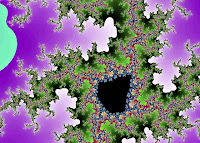Where the world ceases to be the stage
for personal hopes and desires,where we, as free beings,
behold it in wonder, to question and to contemplate,
there we enter the realm of art and science.
If we trace out what we behold and experience
through the language of logic, we are doing science;
if we show it in forms whose interrelationships are not
accessible to our conscious thought but are
intuitively recognized as meaningful, we are doing art.
Common to both is the devotion to something
beyond the personal, removed from the arbitrary.
 |  |
I came upon the piece of prose upon which I still lavish superlatives, must have been twenty years ago. Perhaps more. It was in a book called "The Beauty of Fractals" by H.-O. Peitgen and P.H.Richter, a book which for some years became a sort of Bible to me. There was back then a bit of a fad for fractals. They were cool. Made possible by the advent of the computer in home and school, it was not long before every teenager had one on his bedroom wall. Or so it seemed. They were part of our fascination with Chaos Theory and the intriguing idea that a butterfly flapping its wings in Hong Kong might cause a hurricane to hit the Florida coast. For me, fractals and everything about them are as fascinating now as they were back then. They have not lost their magic. They bring together art, science, mathematics, technology and music (There is such a thing as fractal music.)and represent a form of geometry we had not seen before. Some had intuited it, but no one could see it before computers opened their window on it. It was as unbelievable as much that was happening elsewhere in science and had already happened in the arts.
 |  |
The geometry they taught me at school was Euclid's. It was about shapes in two and three dimensions. They had sides and areas that we could measure and/or calculate. (That was the point of it all.) Fractals possess none of that. They have neither sides nor areas that are measurable. The perimeter of a fractal is infinite. Incalculable. A computer allows you to zoom in on your chosen fragment and to see it as under a magnifying glass, a microscope if you will, even an electron microscope. And however much you magnify it, it is as if you were still looking at the original, your starting point - except that its spirals, whorls, folds, spikes and vortices have become ever more complex. In places it may appear to be disintegrating into dust, but the detail is infinite. You will never get to the end of it.
 |  |
Example: Take an equilateral triangle and place centrally on each of its three sides, another, similar, but with sides one third the length. You now have a Star of David. In the center of each of the new star's twelve sides place another equilateral triangle, its sides again reduced to one third of the previous triangle's. You get the idea. You now have 48 sides requiring triangles with sides again reduced by two thirds. And again on each of the resulting 192 sides. And on through all eternity. The length of the shape's perimeter expands infinitely, yet the triangles you keep adding will never collide with each other. Furthermore, if you were to draw a circle around the first triangle, to touch all three points, your fractal will never stray outside that circle - and you will never draw the complete fractal, not this one nor any other you might attempt by whatever method.
 |  |
The fractals I have drawn here were all produced by an on-line fractal generator, of which there are many. There are also down-loadable versions. There is much experimenting to be done, and anyone can do it. You do not need to be a mathematician. I have chosen fractals from what is known as The Mandelbrot Plot. For the mathematicians among you, they are fragments from the graph of Xn+1=f{Xn} - but, as I say, you do not need to understand that. The variety of results is - you've guessed it! - infinite, the product of where on the plot you decide to search and the parameters you choose. (The fractal generator pages will lead you by the hand.) Happy hunting - oh, and whose pen was it crafted my opening lines? Albert Einstein's.
 |





No comments:
Post a Comment